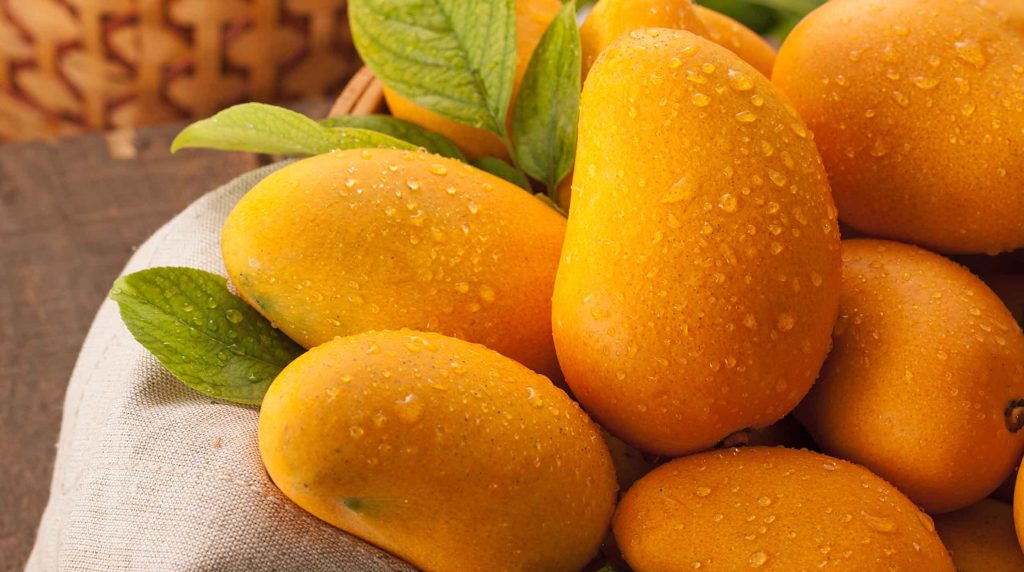Mango
Mangoes, native to India and Southeast Asia, are a rich, nutrient-packed treat enjoyed around the world. The mango offers high levels of antioxidants, copper, folate, and vitamins A, C, E, and K, but it’s the fruit’s intoxicating tropical flavor that has earned it wide appeal as a snack to be eaten on its own or the cornerstone of smoothies, popsicles, lassis, salsas, and more.

Read on to discover the types of mangoes you’re likely to find in the United States, how to tell if they’re ripe, how to cut and store one, and tasty, mango-forward HelloFresh recipes.
The Many Types of Mangoes
The Many Types of Mangoes
If you’re fruit-shopping in the United States, you’re likely to find mangoes that were grown by tropical neighbors Mexico, Ecuador, Brazil, Peru, and Guatemala, along with Florida. Most common in the U.S. are Tommy Atkins—large, meaty, and uniformly oval Floridian mangoes, easy to portion into cheeks and an even dice.
From late February to early August, look for buttery-fleshed and sweet Ataulfo mangoes, or Honey mangoes, from Mexico (the only mango that should be wrinkly when ripe). Mid-April through late June, try Alphonso mangoes—a small, incredibly juicy mango.
Other varieties you may find include Haden mangoes (the most widely grown mango in the world), Frances, Keitt, and Kent.
How to Tell if a Mango Is Ripe
Picking ripe mango comes with a few pitfalls, but mastering these tricks can help ensure you’re getting closer to tropical perfection every time. Remember to use your senses—you can see, touch, and smell your way to the perfect fruit. Here’s how:
The Mango’s Color: Most mangoes are fully ripe when they’re a deep and almost uniform yellow or blushy orange. Green signifies that a mango is underripe and usually too tannic and tart to enjoy out of hand—though green mangoes have some culinary uses, such as Thai green mango salad.
The Mango’s Firmness: Once you’ve eliminated the green-skinned mangoes, feel your way to a winner. Press the fleshy “cheek” of the mango—a ripe mango should give but feel slightly firm (you’ll often see the term “firm, ripe mango” used in recipes). Certain varieties, such as the Alphonso, will be softer when ripe, but a too-tender Tommy Atkins or Haden mango might signify bruising or rotting.
The Mango’s Smell: A ripe mango may be subtly tropical-scented, especially at the stem. Cold mangoes (cold-shipped or stored in a cold location) will be harder to smell, so use this only as a final evaluation criterion.
How to Cut a Mango in 4 Easy Steps
How to Cut a Mango in 4 Easy Steps
To cut a Tommy Atkins, Haden, or other medium-firm, fleshy mango, reach for a large, sharp chef’s knife (see tip below) that can shave off the cheek safely in one fell swoop. To get it right:
Hold your mango upright, with the pit standing straight up from your cutting board. Place the knife at the top center of the mango, along the pit, facing parallel with the flat edge of the pit. Cut down along the pit, releasing one half (or cheek) from the pit. Turn the mango 180 degrees, holding the top firmly, and slice the other half (or cheek) off the pit.
Use a knife to cut the two remaining fleshy sides off the pit, and scrape any flesh into a bowl.
Use a paring knife to cut into the fruit from the flat side down into the rounded portion, toward the skin, creating several parallel cuts. Turn the mango so the cuts are now horizontal, and cut perpendicular to them, creating a grid.
Carefully turn your mango half inside out, pressing the skin side inward with your thumbs, flipping out the mango cubes. Eat them fresh off the skin, or use a paring knife to carefully slice the cubes away from the skin into a bowl. (You can also use a thin, large spoon to scoop out the cubes, leaving the skin behind.) Once you know how to cut a mango into cubes, you can eat them out of hand whenever you like. They’re sweet enough to be an as-is dessert, though you can also gild the lily by serving mango with a scoop of vanilla ice cream.
Mango Cutting Tip: Not so confident with a 9-inch chef’s blade? You can use a sharp paring knife. A small serrated knife can also be used to slowly saw the flesh off the cheek without slipping. This won’t yield a super clean cut (or the beautiful, ready-to-fan-out cheeks you’ve seen on Instagram), but you’ll still get to enjoy all the juicy flesh.
How to Store Mango
To store cut mango, cover the flesh sides completely with plastic film to prevent browning or drying out, and then press the halves together into a whole. Store in an airtight container in the refrigerator for three to five days, but note that it won’t ripen once cut or refrigerated.









